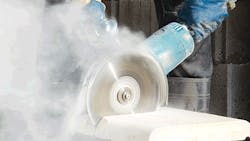New Respirable Silica Rule Poses Problems for Construction Industry
While the respirable silica rule isn't in effect until June 23, 2017 for the construction industry, safety professionals are questioning whether they will be able to stay compliant.
Tressi Cordaro, principal at Jackson Lewis P.C., gave Safety Leadership Conference attendees a road map to its respirable crystalline silica rule and answered some of those questions.
"It's just about everywhere, and trying to regulate it is problematic," Cordaro said. "The question is can employers feasibly do what OSHA is asking them to do?"
The key provisions of the rule state that employers must reduce the permissible exposure limit (PEL) for respirable crystalline silica to 50 micrograms per cubic meter of air, averaged over an eight-hour shift.
In addition, the rule requires employers to use engineering controls to:
- Measure the amount of silica that workers are exposed to if it may be at or above an action level of 25 μg/m3 (micrograms of silica per cubic meter of air), averaged over an eight-hour day.
- Protect workers from respirable crystalline silica exposures above the PEL of 50 μg/m3, averaged over an eight-hour day.
- Limit workers' access to areas where they could be exposed above the PEL.
- Use dust controls to protect workers from silica exposures above the PEL.
- Provide respirators to workers when dust controls cannot limit exposures to the PEL.
- Offer medical exams including chest X-rays and lung function tests every three years for workers exposed above the PEL for 30 or more days per year.
- Train workers on work operations that result in silica exposure and ways to limit exposure.
- Keep records of workers' silica exposure and medical exams.
- OSHA states the new rule will provide flexibility to help employers protect workers from silica exposure, especially those in small business.
Cordaro detailed two ways to comply with the standard: complete frequent exposure assessments and site inspections or follow Table 1 of the rule which details engineering and work practice control methods and the required respiratory protection and minimum assigned protection factor. No matter which method is chosen, employers still face challenges, she said.
While exposure assessment allows the employer to use objective data when monitoring, construction sites are ever-changing, which could cause inaccurate representations of silica levels, making compliance more difficult. This is why frequent exposure assessments would need to be completed, Cordaro explained.
However, the availability of sampling pumps and certified industrial hygiene professionals is an issue. Simply stated, the supply just is not able to fit demand.
"The agency likes to force technology into compliance," she said.
Regardless of the methods chosen to stay compliant, the competent person required by the rule will have a large task on his or her hands. In the case of construction sites, the appointed person will have to do frequent and regular inspections of the job site, materials and equipment and work those into the written exposure control plan.
"The agency believes this person is going to be the key to preventing overexposure," she told the audience.
Lastly, required medical exams could come at "extensive costs" to the employer. Medical surveillance of workers on job sites is a matter of limited resources as well.
"There are just not enough B readers in the country to enforce this," she said NIOSH defines B readers as a certified pool of physicians who are able classify dust-related illnesses using radiograph examination.
